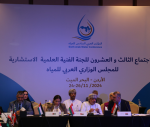You are here
Financing nature
Sep 22,2024 - Last updated at Sep 22,2024
GABORONE — From the Drakensberg mountain range in the west to the Indian Ocean in the east, KwaZulu-Natal province is one of South Africa’s most biodiverse provinces. For the last 30 years, however, deteriorating river water quality and increasingly frequent flooding has been costing its cities, businesses and citizens dearly. But there is hope for KwaZulu-Natal, and for other environmentally distressed regions.
One city in KwaZulu-Natal, eThekwini, showed what an effective response looks like, implementing a comprehensive program for restoring and protecting its rivers using nature-based solutions. Beyond collecting over 100 tons of waste and clearing 98 hectares of invasive species, the initiative has created more than 1,000 jobs since its launch in 2022.
The eThekwini municipality succeeded because it put nature at the center of its climate-action plan. But such success stories remain few and far between. Nature-based investments, including sustainable agriculture, are already proving profitable and scalable, and they have the potential to create 395 million jobs by 2030. Yet, globally, nature-based solutions receive only 15 per cent as much investment as traditional climate solutions, such as clean energy and low-carbon transport. Even harmful subsidies receive 3-4 times more financing than nature-based investment.
As a result, we face a catastrophic and irreversible breakdown of our planet’s ecosystems, a point stressed at last year’s United Nations Climate Change Conference (COP28) in Dubai. To avoid this outcome, progress is needed in a few key areas.
For starters, public and private economic actors must embed nature in their decision-making. Fortunately, a number of tools and enabling frameworks are now available to help businesses and investors identify nature-positive solutions, such as the Kunming-Montreal Global Biodiversity Framework, the Taskforce on Nature-Related Financial Disclosures, the Science Based Targets Network, the Finance Sector Deforestation Action initiative, and the Nature Action 100 initiative.
Central banks and financial regulators can encourage businesses to contribute to nature conservation and restoration by providing nature-related financial risk assessments. Zambia’s central bank, for example, recently integrated biodiversity into its green loan guidelines, so that more financing will be directed toward activities that promote biodiversity conservation and restoration. The framework complements the green bond guidelines that were previously developed by the country’s Securities and Exchange Commission.
Governments should also better coordinate nature-positive initiatives, and climate action more broadly, across ministries and countries, in order to avoid competing agendas. One model, implemented in Rwanda, focuses on measuring and valuing nature. By collecting data on how natural resources are contributing to the economy, the Natural Capital Accounts for Ecosystems ensures that this information is reflected in economic policy and development planning across ministries.
As for international coordination, fora like COPs can help drive progress. At COP26, more than 140 world leaders committed to “halt and reverse forest loss and land degradation by 2030,” while supporting the livelihoods of those who depend on forests and delivering sustainable development. At COP27 and COP28, they demonstrated their ongoing commitment to deliver on this goal, with countries like the Democratic Republic of the Congo and Ghana announcing innovative investment partnerships.
A third imperative is to strengthen the pipeline, and appeal, of nature-positive projects. Since such projects often carry high up-front costs or involve long payback periods, few meet investors’ criteria. It does not help that financial institutions and capital markets tend to view nature-related investments as having an unfavorable risk-return profile.
Concerted action is needed to support project development, such as through regenerative value chains and high-integrity carbon and biodiversity markets. This would facilitate the aggregation of projects, so that they reach sufficient scale to offer attractive returns to investors.
At the same time, efforts must be made to reduce the cost of capital, such as by improving risk sharing and mitigation. Multilateral development banks must play a key role here, not only by reducing and pooling risk, but also by providing transition signals to the wider system, in order to mobilize private capital. More broadly, the quality and quantity of development finance must be improved, with more funding directed to nature-rich emerging markets and developing economies (EMDEs).
For some countries, those currently facing triple climate, biodiversity and debt crises, sovereign-debt solutions will be needed. The 61 EMDEs that are particularly vulnerable to debt distress today will need $812 billion in debt restructured across all creditor classes. Debt relief would free up funding, while robust new climate-finance targets would ensure that these resources are directed toward nature-positive initiatives.
The final step is to ensure that climate- and nature-related investments, initiatives, and policies are just and inclusive. Currently,only 25 per cent of pledged finance reaches projects on the ground. In Asia and Sub-Saharan Africa, smallholder farmers, responsible for 80 per cent of food production, spend as much as $368 billion annually on increasing their resilience to climate change.
Meanwhile, less than 1 per cent of total climate finance goes to the indigenous peoples and local community groups that are the stewards of one-quarter of the planet’s land, representing a carbon-sequestration capacity of 300 billion tons. Giving these groups direct access to finance and respecting their land rights is not only a moral imperative, but also essential to preserve the nature on which we all depend.
In terms of political momentum, financial innovation, and technological capabilities, the stage is set for rapid progress in restoring and preserving nature. World leaders must seize this moment to build a transformative investment agenda that recognizes that, without nature, our planet, let alone our economies, cannot survive. As Kenyan President William Ruto once noted, “When we put nature on our balance sheets, you’ll know Africa is wealthy.”
Razan Khalifa Al Mubarak is UN Climate Change High-Level Champion for COP28 and President of the International Union for Conservation of Nature. Bogolo Kenewendo is Special Adviser for the UN Climate Change High-Level Champions for COP27-28 and a former minister of investment, trade, and industry of Botswana. Copyright: Project Syndicate, 2024. www.project-syndicate.org












Add new comment